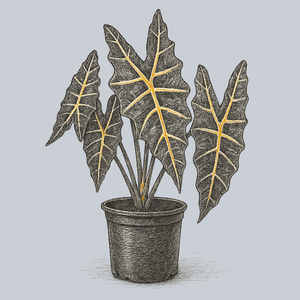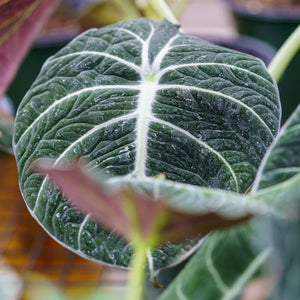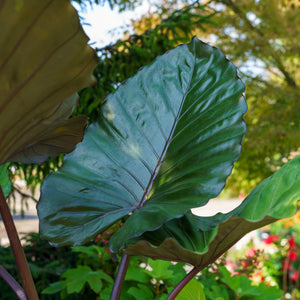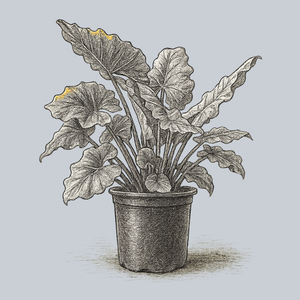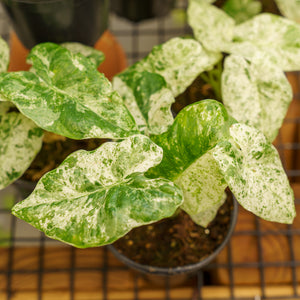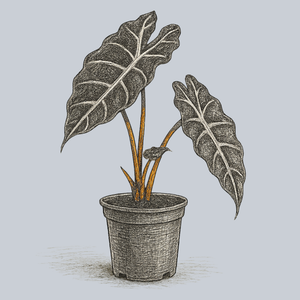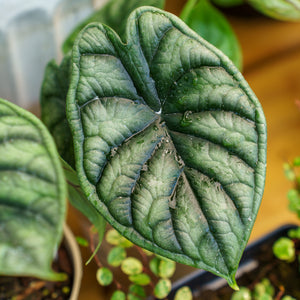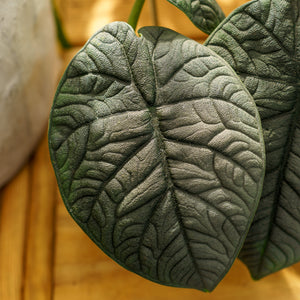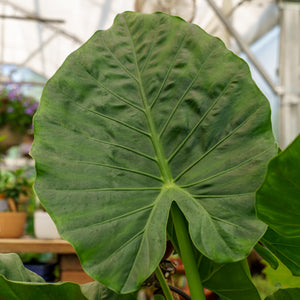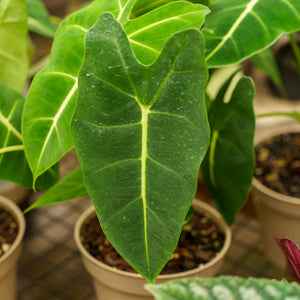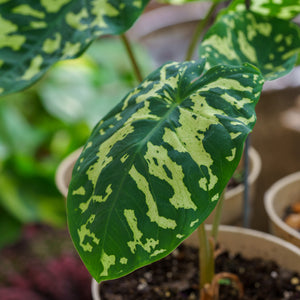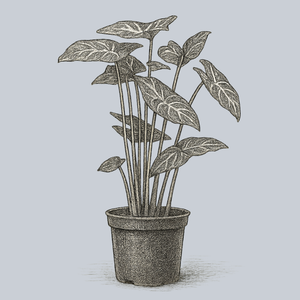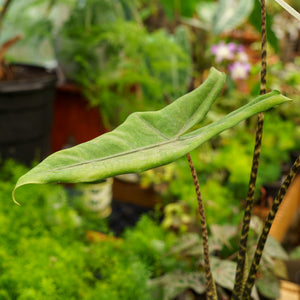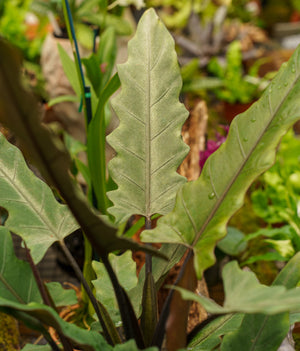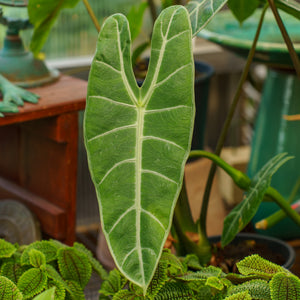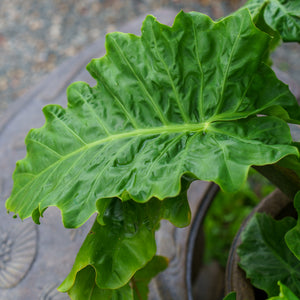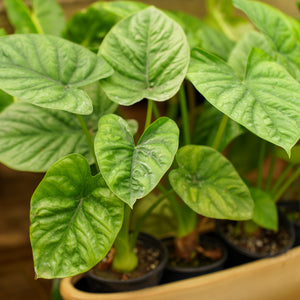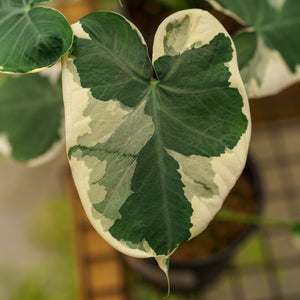The Alocasia Guide
Alocasia, commonly known as Elephant Ear or African Mask Plant, is a genus of broad-leaved, rhizomatous, or tuberous perennials native to tropical and subtropical Asia and Eastern Australia. Renowned for their dramatic and uniquely patterned foliage, Alocasia plants make a bold statement in any setting. Their striking leaves, which vary from deep green to silvery hues with contrasting veins, create a dramatic visual effect that adds a touch of the exotic to indoor and outdoor spaces. These plants are highly valued for their architectural form and the lush, tropical atmosphere they bring.
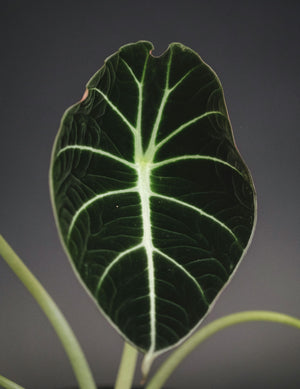
About
Alocasia is a genus in the Araceae family that features more than 70 recognized species. These plants are celebrated for their large, sculptural leaves, which often take on heart or arrowhead shapes. Commonly referred to as Elephant Ear plants, their foliage is adorned with intricate patterns and bold veins, offering a dramatic contrast that elevates any space.
Native to the tropical regions of Asia and Eastern Australia, Alocasia thrives in humid environments but has adapted well to indoor and outdoor cultivation in diverse climates. Varieties like ‘Dragon Scale,’ ‘Black Velvet,’ and ‘Silver Dragon’ feature stunning textures and colors that enhance their appeal. The silvery tones of ‘Camouflage Variegated’ and the rich hues of ‘Red Secret’ showcase the incredible range within this genus.
Beyond aesthetics, Alocasia contributes to improved indoor air quality and serves as a striking focal point in gardens or interior spaces. While they demand attentive care, their beauty and versatility make them a rewarding choice for enthusiasts and beginners alike.
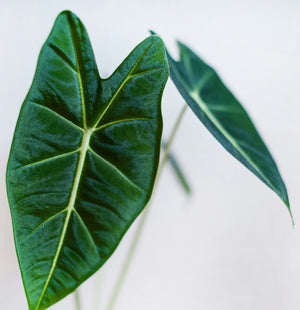
Planting
Planting Alocasia successfully requires thoughtful preparation and care:
- Soil: These plants thrive in well-draining, nutrient-rich soil. A mix of peat, perlite, and potting soil provides the ideal growing medium. Slightly acidic to neutral soil with a pH of 5.5 to 6.5 is recommended.
- Sunlight: Alocasia prefers bright, indirect light. While it can tolerate partial shade, filtered light enhances growth and leaf coloration. Avoid prolonged exposure to direct sunlight, which can scorch the leaves.
- Watering: After planting, water thoroughly to settle the soil. Maintain consistent moisture, allowing the top inch of soil to dry slightly between waterings. Overwatering can lead to root rot, so ensure proper drainage.
- Humidity: High humidity levels are essential for Alocasia. Consider using a humidifier, misting the leaves, or placing a humidity tray nearby to maintain the moisture levels they need.
- Mulching: Apply organic mulch, such as bark or coconut coir, around the base to retain soil moisture and regulate temperature. Leave space between the mulch and the stem to prevent rot.
Proper planting practices ensure your Alocasia establishes well and thrives, becoming a lasting addition to your space.
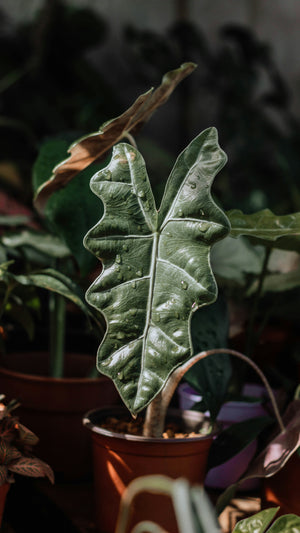
Care
Alocasia plants require specific care to maintain their vitality and striking appearance:
- Watering: Water consistently during the growing season, keeping the soil moist but not soggy. Reduce watering in winter when growth slows, allowing the soil to dry out slightly between waterings.
- Fertilizing: Feed with a balanced, water-soluble fertilizer every 4-6 weeks during spring and summer. Follow package instructions to avoid over-fertilization, which can damage the plant.
- Pruning: Remove yellowing or damaged leaves as needed to maintain a neat appearance and encourage new growth. Wipe leaves with a damp cloth to keep them dust-free.
- Pest and Disease Management: Watch for pests such as spider mites, mealybugs, and aphids. Treat infestations promptly with insecticidal soap or neem oil. Proper air circulation and avoiding overwatering can help prevent fungal diseases.
With attentive care, Alocasia plants will reward you with vibrant foliage and enduring beauty.
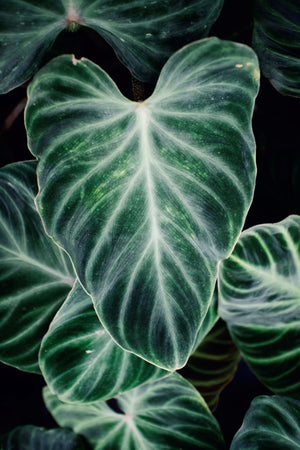
How To Use
Alocasia offers numerous possibilities for enhancing your indoor and outdoor spaces:
- Focal Points: Showcase varieties like ‘Frydek’ and ‘Ivory Coast’ as striking focal points in your garden or interior spaces. Their bold foliage draws the eye and creates visual drama.
- Indoor Tropical Vibes: Bring the jungle indoors with ‘Black Velvet’ or ‘Jungle Cat.’ These plants thrive in well-lit rooms and add a lush, tropical feel to any setting.
- Container Gardening: Cultivate Alocasia in stylish pots to move them easily between indoor and outdoor areas. Containers allow for creative placement and enhance their decorative appeal.
- Mixed Plantings: Pair Alocasia with shade-loving plants like calatheas and ferns. The contrasting textures and colors create stunning plant groupings.
- Water Features: Enhance ponds or fountains with varieties like ‘Lauterbachiana’ or ‘Longiloba,’ whose dramatic leaves add an exotic touch to water gardens.
- Office Greenery: Smaller varieties such as ‘Polly’ and ‘Mickey Mouse Plant’ are perfect for desks or office corners, adding a splash of green with minimal care.
Alocasia’s versatility makes it an asset in any setting, transforming spaces with its bold and tropical charm.
Conclusion
Alocasia, with its bold and eye-catching foliage, is an exceptional choice for those looking to elevate their indoor or outdoor environments. These plants combine aesthetic appeal with adaptability, making them suitable for diverse settings and care levels. By following the planting, care, and usage guidelines, you can ensure your Alocasia thrives and continues to captivate for years to come.
Whether you’re seeking a dramatic focal point, an elegant indoor feature, or a tropical garden accent, Alocasia offers endless possibilities. Explore the diverse varieties, such as ‘Dragonite’ and ‘Quilted Dreams,’ and discover how these remarkable plants can transform your space into a lush, inviting haven.

